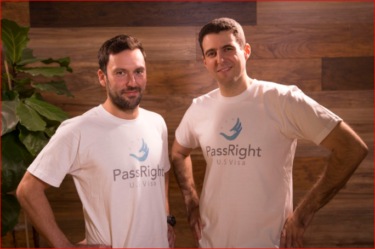In the face of the unfortunate events occurring on the US’ southern board, with families being inhumanly separated, it can be difficult to see the country as the same beacon of hope that it once represented for so many immigrants many years ago. Ironically, this government and its immigration averse policies come at a time when the US requires overseas skills more than ever. For example, it is estimated that 1.4 million computing and engineering positions will need to be filled by 2020, however, studies have predicted that universities will only graduate approximately 400,000 computer science graduates by that time.

Liran Rosenfeld, CEO of PassRight
The obvious answer for this would be to encourage more talent from overseas to fill this gap. Unfortunately, this does not seem like a popular decision in the current political climate, especially given this president’s previous approach to DACA and immigration in general. To get a better idea of the situation and what the future holds we spoke with Liran Rosenfeld, CEO of PassRight, a SaaS Company providing technology to Immigration Law Firms.
What was the main motivator to solve this problem, for example, did it arise from a personal experience or something you recognized others having issues with?
As a foreigner, when moving to the US, I struggled to get my GreenCard. It is definitively from personal experience. I spent $20,000 on immigration attorneys. I received conflicting recommendations on which visa I can get and eventually took a advice from an immigration attorney who suggested I avoid the next 10 years in and out of the USCIS office and go directly with a green card based on EB-1.
The experience was stressful. The attorney spent months preparing the case. I never saw the case before it was submitted. I had no control over my case and eventually, the case was full of mistakes and almost got denied. I had to repeat the process. I later sat for a few months working inside an immigration law firm in San Diego where I saw all the inefficiencies immigration lawyers and paralegal make. Immigration is a high volume practice and attorneys make mistakes all the time. Attorneys’ skills are for certain visas and not necessarily what’s really great for an applicant.
When hiring an attorney, you are facing a tedious process. A process that involves a meeting with an attorney (paid consultation) later signing an attorney-client agreement where the client basically loses all rights and is in the hand of the law firm. Then the document preparation and form filling can take months. I did not know the attorney success rate, the likelihood of success, what is happening in my case and I could not even review it. The process is slow, expensive and relatively scary.

Liran Rosenfeld and Gal Talmor (CEO & CTO on the right)
Can you give an example of a company or case study that has really benefited from Passright?
PassRight has helped over 700 immigrants to get their work visas, green cards or visa renewals. We help students, skilled employees, startup founders, computing job experts/engineers, artists, actors, singers, investors and executives that transfer between companies.
What is the main focus for Passright over the next 6 months?
Passright will focus on helping more people, especially those who have great skills but didn’t get their H1Bs. We are focusing on helping H-1B rejects. Most people that can qualify for O-1, EB-1 Eb-2. Skilled employees or artists. We also help foreign students.
Our platform serves daily people who need all kinds of immigration help. We have automated marriage-based green card petitions, Green Card renewal, citizenship applications, B-1 B-2 visa extensions, O-1 renewals and O-1 Visa
It is currently a very turbulent time for foreigners looking to move to the US. Do you foresee things changing for the better or the worse over the next 2 years?
We see that while the H-1b is getting harder to obtain, all the other visas are as obtainable as before. We help people get their O-1 as an alternative to H-1B. Immigration is evergreen and we see that foreigners looking to move the US will be able to do so just as before. The process takes a little more time for certain visas but in general immigration works pretty much the same.
For some types of people there are even nicer options than before. For example, Researchers and PHds have more options today than before. E-2 as an investor visa is becoming available to new countries and immigration for investors, business people and talented skilled employees are just as available today as it was 3-4 years ago.
Do you believe the US’ lack of qualified professionals to fulfill high tech jobs will come to a boiling point, forcing the US to rethink its immigration policies?
Definitively. There is a shortage of 1M computing jobs in the U.S. you can already tell that some visa departments like the O-1 are approving qualified candidates faster than before. There is visa alternative for qualified professionals. There is a gap of information on how to obtain those.
On a somewhat separate note, I can see from your Linkedin profile you speak 6 languages. Do you have any advice for any readers that hope to visit or move to another country and are trying to pick up the local language?
It is like everything, you need a strong interest, getting yourself out there and have the necessity to learn. A lot of people either don’t care, either blend with people that have the same nationality as soon as they get to a new place. I recommend reading books and listening to Podcasts or Audible. It helped me refine me America English.
Liran’s wife is Polish and today Liran is learning Polish. Liran has always had a strong interest in travels and languages. It’s all about persistence.












